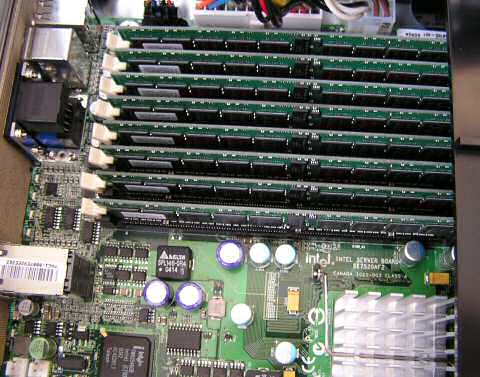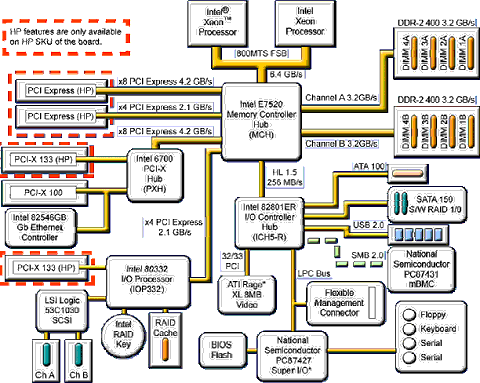Dual CPU Database Server Comparison
by Johan De Gelas on December 2, 2004 12:11 AM EST- Posted in
- IT Computing
The newest addition: Intel's Lindenhurst server
Our Dual Intel Xeon 3.6 GHz server was based on the Lindenhurst chipset, a server chipset similar to the i925 desktop chipsets.
The Intel Server Board SE7520AF2 is one of the first boards to make extensive use of the real world advantages that PCI Express and DDR-II offer in the server world. This is in contrast with the desktop market, where DDR-II is mostly a much more expensive and only marginally faster alternative to DDR SDRAM.
One of the problems of SDRAM is that the complete address and command bus must be connected to each chip. (The databus does not have this problem - the 8 chips are connected to 8 parallel wires.) To make it worse, addresses and commands must be presented to all DRAM chips on a DDR DIMM at the same time.
You can read more about it here. To make a long story short: one of the most important reasons for limiting the number of SDRAM chips per memory channel is the load and thus, signal integrity on the address bus. DDR-II has the same problem, but many of the new features (OCD-calibration, On Die termination, BGA packaging, lower differential voltage swing) of DDR-II improve signal integrity significantly compared to DDR-I.
Secondly, DDR-II consumes almost 30% less than comparable DDR-I DIMMs, which is a big advantage if you consider that each GB of DDR-I consumes about 10 watts. Especially in a 64 bit server, where you want to use more than 4 GB of RAM, this will be a nice improvement.

The result is that the Lindenhurst board can offer 4 DIMMs per channel while the other Xeon servers with DDR-I were limited to 4 DIMMs in total, or one per memory channel. This might seem trivial, but it neutralizes an advantage that the Opteron previously had over the slightly older Xeon: it is cheaper to use 8x 1 GB than to use 4 x 2 GB. More DIMM slots result in more flexibility; a lower price per GB or a higher maximum RAM capacity.

Thirdly, the E7520 chipset makes a full duplex 2.1 GB/s x8 PCIe slot and an x4 PCIe slot available, in addtion to the typical 100 and 133 MHz PCI-X slots that we find in many servers.
The 7520 chipset is also the first server chipset with a FSB of 800 MHz, which connects to two channels of Registered ECC DDR2 400 memory. While the latter does not have the bandwidth of their 533 MHz / 667 MHz brothers, the actual latency (3-3-3, 5 ns) is pretty low, which is, for most server applications, more important than raw bandwidth.
The new serverboard also includes an updated version of Intel's Server Management 8 solution and has a dual-channel Ultra320 SCSI controller on board. Notice the white rectangle at the bottom of the server, which contains the RAID cache and battery backup of this RAM cache.










46 Comments
View All Comments
JohanAnandtech - Thursday, December 2, 2004 - link
About SLES9 and NUMA: NUMA is also supported by Linux kernel 2.4.21 and it boosts performance only a tiny bit. The reason are the very speedy HT links which keep latency at a minimum.It is still possible that kernel 2.6 NUMA support is far better of course, but I doubt it makes a difference for quad or dual systems as there is only hop in quad systems. With two hops (8 CPUs) from CPU 1 to 8 for example, this will become important.
AtaStrumf - Thursday, December 2, 2004 - link
A TYPO:So for now, the Opteron has an advantage still, but it ***can*** /can't/ knock out the Xeon, as it could have a few months ago, before the Xeon Nocona arrived.
HardwareD00d - Thursday, December 2, 2004 - link
There have been enough benchmarks on the web for a long time which show that Opteron generally wipes Xeon's a$$ hands down, and scales far better in multi processor configurations. The latest Xeon is nothing special compared to prior versions and will no doubt preform better mostly due to its increased clock speed. Xeon will never be better than Opteron no matter how much cache and tweaks Intel adds.Maybe Intel's next server architecture will be something to woo, but that's a ways off.
jshaped - Thursday, December 2, 2004 - link
as a long-time reader of aceshardware, i'll be the first to welcome Johan here, great first article. keep them coming!!!!HardwareD00d - Thursday, December 2, 2004 - link
I don't think there are enough variations of the way requests are handled to make a realistic conclusion for either chip. I'm sure you could create a situation where Intel bests AMD in My Sql, and vice versa. This article really needs more benchmarks and more in-depth analysis. Still, it provides enough information to conclude that both Xeon and Opteron have their strengths and weaknesses.mczak - Thursday, December 2, 2004 - link
Nice read. I really think though you should have used SLES 9. Not only does it use kernel 2.6, but it's also NUMA-aware (and DB2 should specifically support it, though it might not have been released yet). SLES 9 also ought to be faster especially on x86_64 due to newer compiler (not that it would matter much with precompiled databases, but every bit counts...). Though for 2-cpu boxes, NUMA might not be that important - but it's safe to predict a landslide victory for a 4-cpu opteron with NUMA support vs. a 4-cpu xeon box. Xeons simply don't scale to 4 cpus, intel might sell them but they are useless (especially since the Xeon MPs are still limited to 400 (or was that 533?) Mhz FSB.A pity though the quad opterons don't support ddr-400. I guess manufacturers decided it's more important to have a boatload of ram slots than fewer slots (with shorter traces) with higher speeds...
And btw, where are the 90nm Opterons? AMD's latest roadmap shows them as available in 2004, which doesn't leave too much time...
bthomas - Thursday, December 2, 2004 - link
Bogus conclusions about IBM tests IMO. From the
article:
> If we had published a similar report back in
> August, the Opteron would enjoyed a landslide
> victory. Luckily for Intel, Nocona is very
> competitive and is about 5% faster than the Opteron 250.
and later in the "conclusion":
> Nevertheless, AMD cannot sit on its laurels.
> Intel made a very good comeback with Nocona, as > this 3.6 GHz CPU is just a tiny bit faster in >
DB2.
It has not.
You fail to specify that this is comparing the _32 bit_ mode for the Opteron. IF you compare the Nocoma performance to the Opteron 64 bit capability...it sweeps the the Nocona in all tests.
The true conclusion is that based on the results in the article, for neither of the databases tested do *any* of the Intel processors compete with the Opteron.
fitten - Thursday, December 2, 2004 - link
Randomized benchmarks are hard to verify as well. You could get a "good" distribution that really takes advantage of cache locality while another randomization may be very cache unfriendly. I agree with #5 to a degree. A database that fits entirely inside of RAM isn't very interesting, ultimately.Still, I am happy that AnandTech is going down these paths of benchmarking instead of just being about Doom3, HL2, and FarCry like most other sites. I eagerly await further database benchmark articles.
PrinceXizor - Thursday, December 2, 2004 - link
#5 - Since when do top tier e-commerce cites compare to mid-level company database users as the beginning of the article mentioned?My company is an engineering firm that does custom electronics. Our database server handles all the transactions for our Inventory/MRP system which is mostly reads. These benchmarks are very appropriate. I wish I could have convinced my boss to go Opteron. Its funny, they had Athlon MP's before and then switched to Xeons when Opteron was out. Go figure.
Anyway, great article. I'm not IT guy by any stretch, but I enjoyed the article.
P-X
Jason Clark - Thursday, December 2, 2004 - link
#6, done ages ago..http://www.anandtech.com/IT/showdoc.aspx?i=2205
http://www.anandtech.com/IT/showdoc.aspx?i=1982